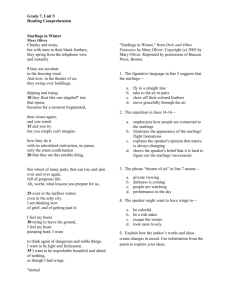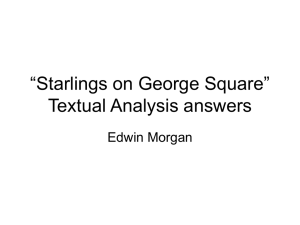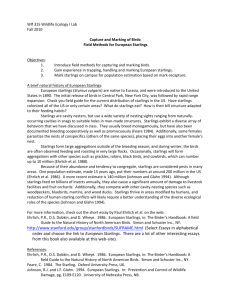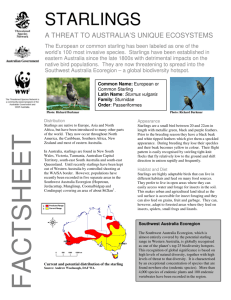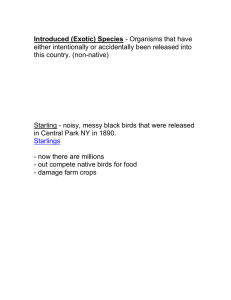Fisheries and Wildlife presented on Abstract approved:
advertisement
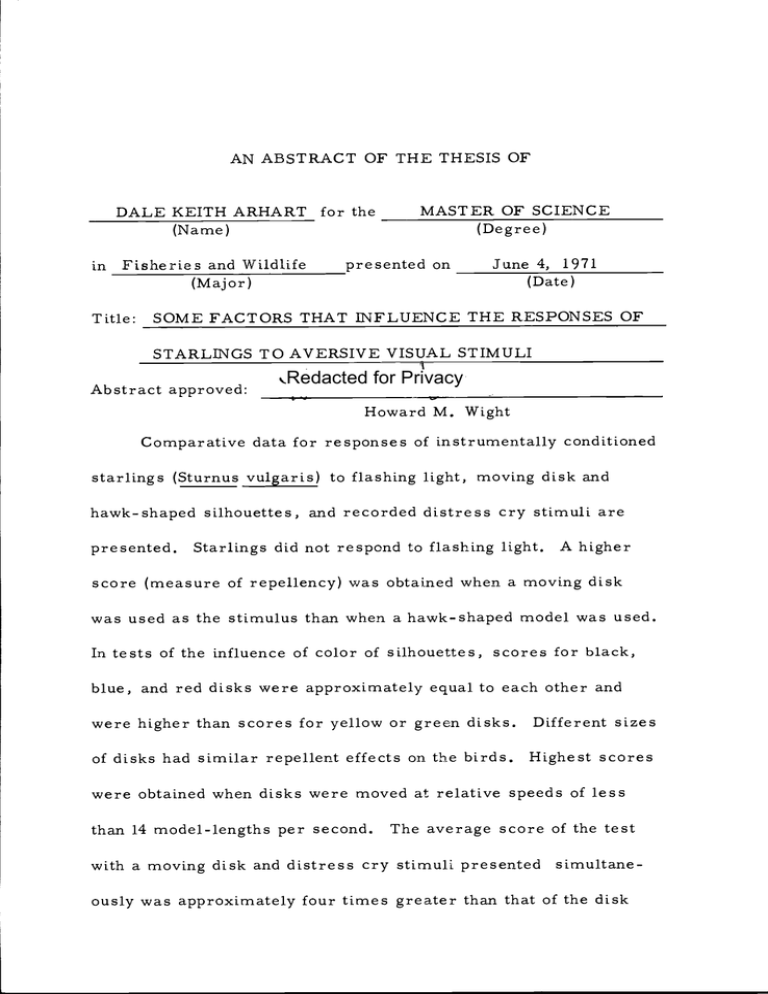
AN ABSTRACT OF THE THESIS OF DALE KEITH ARHART for the (Name) in Fisheries and Wildlife MASTER OF SCIENCE (Degree) presented on June 4, 1971 (Date) (Major) Title: SOME FACTORS THAT iNFLUENCE THE RESPONSES OF STARLINGS TO AVERSIVE VISUAL STIMULI Redacted for Privacy Abstract approved: Howard M. Wight Comparative data for responses of instrumentally conditioned starlings (Sturnus vulgaris) to flashing light, moving disk and hawk-shaped silhouettes, and recorded distress cry stimuli are presented. Starlings did not respond to flashing light. A higher score (measure of repellency) was obtained when a moving disk was used as the stimulus than when a hawk-shaped model was used. In tests of the influence of color of silhouettes, scores for black, blue, and red disks were approximately equal to each other and were higher than scores for yellow or green disks. Different sizes of disks had similar repellent effects on the birds. Highest scores were obtained when disks were moved at relative speeds of less than 14 model-lengths per second. The average score of the test with a moving disk and distress cry stimuli presented simultaneously was approximately four times greater than that of the disk presented alone and seven times greater than that of the distress cries presented alone. A red, circular-shaped model moving at a relative speed of 9 model-lengths per second protected a cherry orchard from depredation by starlings. The same stimulus failed to repel starlings from a holly plantation. Some Factors That Influence the Responses of Starlings to Aversive Visual Stimuli by Dale Keith Arhart A THESIS submitted to Oregon State University in partial fulfillment of the requirements for the degree of Master of Science June 1972 APPROVED: Redacted for Privacy Professor of Wildlife EVology in charge of major Redacted for Privacy Head of Department of Fisheries and Wildlife Redacted for Privacy Dean of Graduate School Date thesis is presented June ti, 1971 Typed by Renee D. Rill for Dale Keith Arhart ACKNOWLEDGEMENT Gratitude is expressed to Mr. Howard M. Wight, Professor of Wildlife Ecology, Department of Fisheries and Wildlife, for his helpful guidance, assistance, and criticism in the conduct of my research and during the writing of this thesis. Grateful acknowledgement is made to Mr. Vincent Bogatich and Mr. Kenneth Larson, U.S. Fish and Wildlife Service, for assistance in obtaining the experimental birds. I am greatly indebted to Mr. Everett Mendell and Mr. William Ryan for allowing me to conduct studies on their properties. TABLE OF CONTENTS Page INTRODUCTION 1 METHODS AND MATERIALS 3 Training and Testing Presentation of Stimuli Field Tests 3 RESULTS AND DISCUSSION Flashing Light Comparison of Hawk Silhouette and Disk Color of Disk Size of Disks Speed of Moving Disk Combination of Moving Disk and Distress Cries Field Trials Starlings Feeding in a Cherry Orchard Starlings Roosting in Holly Trees 6 7 10 10 12 16 19 20 23 27 27 29 CONCLUSIONS 31 BIBLIOGRAPHY 32 APPENDIX 34 LIST OF TABLES Page Table 1 2 Scores of individual birds, average value for each tier, and composite average for each test of flashing light. 11 Dominant wave length, percent purity, and reflectance values for the colors of paper used in this study. 17 LIST OF APPENDIX TABLES 1 2 3 4 5 6 Scores of individual birds, average scores for each tier, and composite average for each test of hawk and disk models. 34 Scores of individual birds, average value for each tier, and composite average for each test of color. 35 Scores of individual birds, average value for each tier, and composite average for each test of size.with stimuli 54 in. from cage. 36 Scores of individual birds, average value for each tier, and composite average for each test of size with stimuli 42 in. from cage. 37 Scores of individual birds, average value for each tier, and composite average for each test of velocity. 38 Scores of individual birds, average value for each tier, and composite average for each test of distress cries and presentation of distress cries and a moving black disk. 39 LIST OF FIGURES Page Figure I 2 3 4 5 6 Diagram of apparatus used for presentation of experimental visual stimulus under field conditions. Paper models (x ) used to test the reactions of starlings to moving visual stimuli. Relationship between score and the shape and direction of movement of silhouettes made of black paper. Relationship between score and color of moving disks. Relationship between score and absolute size of black disks 54 and 42 inches in front of the cages. Relationship between score and angular size of black disks 54 and 42 inches in front of the cages. 8 13 14 18 21 22 7 Relationship between score and velocity of a disk with a diameter of four inches. 24 8 Relationship between score and stimuli. 26 SOME FACTORS THAT INFLUENCE THE RESPONSES OF STARLINGS TO AVERSIVE VISUAL STIMULI INTRODUCTION This is a report on certain factors that may influence the responses of starlings to visual stimuli. Effects of shape, color, size, and speed of moving silhouettes, simultaneous presentation of audio and visual stimuli, and effectiveness of flashing light are discussed. Visual stimuli such as imitation hawks, owls, and snakes, paper or metal streamers, whirling objects, scarecrows, and helicopters have been widely used in attempts to repel nuisance birds (Seubert, 1964 and Merrill, 1967). Little data have been obtained that allow evaluation of the effectiveness of such stimuli (Frings and Frings, 1967), and the success of visual repellents has been variable (Mitchell, 1960 and Frings and Frings, 1967). I conducted studies to identify some factors that influence the effectiveness of visual stimuli in repelling starlings. Identification of such factors should enable the design of visual repellents that are more consistently effective. Reactions of starlings in the field are difficult to quantify, therefore my experiments were conducted primarily in a laboratory. The most effective visual stimulus (as indicated by data from laboratory experiments) was also evaluated by presenting it to starlings in the field and observing their reactions. 3 METHODS AND MATERIALS Training and Testing Langowski, Wight, and Jacobson (1969) developed techniques for evaluating aversive stimuli by measuring behavior patterns of starlings that were instrumentally conditioned. Similar techniques were used in this study. Starlings used in this study were trapped near Yakima, Washington and Portland, Oregon. The birds were held in a large pen from which they were randomly selected for testing. A dif- ferent group of eight birds was used for each test. Age and sex of starlings were determined by methods described by Kessel (1951). The tests were performed in two rooms, each 7 x 8 x 10 ft. During tests, birds were placed in individual cages (1Z x 14 x 30 in.).. Eight cages were racked in two tiers of four cages each. Each cage contained two perches, one at the front and one near the rear of the cage. A small plexiglass door controlled access to the food cup attached to the front of each cage. A 6-volt DC solenoid, which was triggered by the rear perch, operated the plexiglass door. Birds stood on the front perch while feeding. Electrical power to the solenoids was controlled by electronic timers (automatic reset type). Intervals during which electrical 4 power was available to the solenoids were termed the feeding cycles. Periods between feeding cycles were termed off-intervals. The start of each feeding cycle was signalled by the illumination of a 10-watt, red light. Once the plexiglass door was opened by the birds depressing the rear perch, it remained open until the end of the feeding cycle. The birds were trained by trial and error to respond to the red light by depressing the rear perch before moving to the front perch to feed. Throughout the training and testing, the birds were able to obtain food only by making the correct response. Each group of birds was trained over a period of five days during which the feeding cycle was progressively shortened from 30 to 8 seconds and the off-interval progressively lengthened from 30 seconds to 8 minutes. An event recorder (Esterline-Angus) connected to both front and rear perches was used to monitor reactions of the birds. Depression of the perches during the feeding cycles was recorded on a recorder chart and indicated those feeding cycles in which the bird reponded correctly. Such cycles were considered successful feeding cycles. Responses of the birds were monitored on day six in order to identify any birds that were not sufficiently trained. Such birds 5 were considered ineligible for testing. A bird was considered ineligible for testing if ten or more unsuccessful feeding cycles occurred in a 5-hour period (34 feeding cycles). On day seven, the test of a stimulus was made. Stimuli were presented only during the feeding cycles. Monitoring reac- tions of the starlings on day seven allowed measurement of the difference in reactions between day six and day seven; the difference presumably resulting from altered behavior caused by presentation of the stimulus. Presentation of a stimulus caused the birds to stop feeding until they became habituated to the stimulus. Habituation is a learning process which results in the loss of response to a stimulus which is repeated without reward or punishment (Manning, 1967). The number of unsuccessful feeding cycles prior to habituation to a stimulus was considered a measure of the repellency of that stimu- lus. A bird was considered to have become habituated to a stimulus when it sucessfully fed during four consecutive feeding cycles. Because each bird was in visual contact with other birds in the same tier, scores for each tier were averaged. The mean score for the test was computed from the tier averages. The electrical components used in the laboratory are described in greater detail by Langowski etal., (1969). Presentation of Stimuli Stimuli tested were flashing light, moving silhouettes and recorded starling distress cries. A stroboscope (General Radio Strobotack 1538A) was used to present flashing light. It was positioned 5 ft. in front of the cages at a height midway between the tiers of cages. Silhouettes were attached to each end of a thin metal strip 30 in. long. This strip was connected at its center to the shaft of an electric motor (Power-Kraft model YWL 4520B). When the motor was cerating, the silhouettes moved in a vertical circle with a radius of 15 in. Velocity of the silhouettes (revolutions per mm- ute of the motor) was regulated with a General Electric speed control (model 5255-A). A plywood panel was positioned so the birds could not see the motor and the lower half of the circular path of the silhouettes. Birds under test were able to see the silhouettes move through an arc of approximately 160°. Silhouettes were positioned 54 in. and 42 in. in front of the cages. Because relative velocity may be more meaningful than absolute velocity (Schleidt, 1961), both absolute velocity (inches per second) and relative velocity (model-lengths per second) were measured. A tape deck playing a continous-play tape at a speed of 7 3 314 inches per second was used to present recorded starling distress cries. Output of the tape deck was fed into an amplifier and resulting stimuli were projected by speakers (University CLC) positioned 5 ft. in front of the cages. A General Radio sound - level meter was used to measure the intensity of the stimulus in decibels. Field Tests For field tests (tests with free-flying birds) a visual stimulus moving in a horizontal, circular path was presented. The stimulus was presented at a height above surrounding vegetation so it was easily visible to approaching birds. A diagram of equipment used to present the visual stimulus during field tests is shown in Figure 1. The stimulus was fastened to one end of an 8-ft. section of metal conduit. This section of conduit was fastened at right angles to the upper end of another section of conduit which was positioned vertically to hold the stimu- lus in an elevated position. The vertical conduit consisted of two 10-ft. sections. The upper section had a diameter of 0. 5 in. and the lower section a diameter of 1 in. The upper section of conduit was placed inside the lower section of conduit so the height could be adjusted by Figure 1. Diagram of apparatus used for presentation of experimental visual stimulus under field conditions. The gasoline engine rotated the vertical section of conduit thereby moving the stimulus in a horizontal circular path. ro] Z ft. 6 ft. 2. ft5- -Stimulus riter balance al conduit istable metal post 1 ms r e dU ingine Ct ion pulling the upper section out to the desired length. This allowed adjustment from 10 to 20 ft. An adjustable (in length) metal post was used to support the conduit. A gasoline engine (Briggs and Stratton, four horsepower) was used to rotate the stimulus in a circular path with a diameter of 12 ft. A gear reduction (49:1 ratio) was used to reduce the speed of the stimulus. The engine and gear reduction were bolted to a wood base (2 x 12 x 24 in.). The field apparatus was easily disassembled for transportation. Stimuli were presented in areas where starlings had been observed to be active. Reactions of birds to the stimuli were observed and recorded. Since comparable control areas were not available, field tests were not controlled experiments. 10 RESULTS AND DISCUSSION Flashing Light Tests were conducted to determine the aversive quality of flashing light. Adult male starlings were tested at frequencies of 500, 700, and 900 flashes per minute. These frequencies are well within the range of frequencies at which separate flashes can be distinguished by birds. The frequency at which fusion occurs (frequency at which flashes appear as a steady light) for most birds is slightly higher than that for man (approximately 1200 flashes per minute for man) (Graham, 1965). The room in which these tests were conducted was lighted by two 150-watt incandescent lights to approximate daylight. The highest score obtained from tests of flashing light was 3. 0 (Table 1). Because none of the scores was significantly dif- ferent from zero (P0.05), no further tests of flashing light were conducted. Based on the failure of starlings to respond to flashing light, I conclude that flashing light would have little value as a starling repellent under conditions of daylight. Table 1. Scores of individual birds, average value for each tier, and composite average for each test of flashing light. Subjects were adult males. Average Individual Scores Flashes per Bottom Tier Top Tier minute Top Bottom Tier Tier Composite 500 1 0 -- -- -- 1 0 7 0.5 Z.6 1.5 700 4 1 13 -- 0 -- -- 0 6.0 0.0 3.0 900 -- -- -- 2 -- 1 1 1 2.0 1.0 1.5 I- 12 Comparison of Hawk Silhouette and Disk Tinbergen (1948) studied the reactions of several species of birds to moving silhouettes of various shapes and hypothesized that birds innately fear a moving silhouette which resembles a hawk. In my tests to determine if starlings exhibit such innate fear, moving silhouettes resembling a hawk and a disk (Figure 2) were presented in separate tests to juvenile starlings of mixed - sexes. The silhouettes were made of black paper. The hawk silhouette was 5.25 in. long with a wingspan of 9 in. The disk was 5.25. in diarrter. The silhouettes moved at a speed of 14 i.p.s. (2.7 model-lengths per second). Tinbergen reported much stronger responses by birds to a hawk model moved head- first than to the same model moved tailfirst, therefore I tested the reactions of starlings by moving the hawk silhouette in both headfirst and tailfirst directions. The responses of the starlings to the disk resulted in an average score of 21.0. This score is significantly higher (P =0.01) than either the average score recorded when the hawk model was moved headfirst (13. 8) or when the hawk model was moved tailfirst (8.3) (Figure 3). Moving the hawk model tailfirst resulted in a lower score than was obtained by moving the model in a headfirst 13 Figure 2. Paper models (x! used to test the reactions of starlings to movig visual stimuli. 14 50 40 30 SCOR 20 10 Hawk model (headfirst) Hawk model Disk (tailfirst) Figure 3. Relationship between score and the shape and direcüon f movement of silhouettes made of black paper. Subjects were juveniles of mixed-sexes. Dots represent the average score. Vertical lines to the left of the average show the range of scores for the birds on the bottom tier; vertical lines on the right of the average are for the top tier of birds. A short line perpendicular to the vertical range lines represents the average score for that group of birds. Scores of individual birds are presented in Appendix Table 1. 15 direction, but the difference was not significant (P = 0. 05). T inbergen (1957) tested turkeys (Meleagris gallapavo), graylag geese (Anser anser), and mallards (Anas platyrhynchos) in his investigation of the relationship between the escape response and the shape of moving silhouettes. The turkeys and mallards were particularly frightened by any model with a relat ively short neck (hawk) and much less frightened by a disk or long-necked (goose) model. The geese were equally frightened by any shape tested. Hirsch, Lindley, and Tolman (1955) used domestic chickens (Gallus gallus), Melzack, Penick, and Beckett (1959) used mallards, and McNiven (1960) used domestic chickens, wild mallards, and pheasants (Phasianus coichicus) in similar studies. These investigators found no differences in responses to differently shaped silhouettes. In one of my tests, starlings were exposed to a moving disk on day seven until all trained birds had habituated (8 hours). On day eight, a test was conducted using the same birds, but substituting a hawk model as the stimulus. This test resulted in a score that was not significantly different from zero (P = 0. 05) (Appendix Table 1). On the basis of this test, it appears that once starlings have habituated to a stimulus, changing the shape of the 16 stimulus results in no response. My comparison of the responses of starlings to a hawk model and disk did not indicate innate fear of the hawk silhouette by starlings. On this basis, I would conclude that under field conditions, a circular-shaped model would be equal to or more effective than a hawk model. Color of Disk Black, blue, red, green, and yellow disks were presented to juvenile starlings of mixed-sexes to determine the influence of color. The disks were 5.25 in. in diameter and moved at a speed of 14 i. p.s. (2.7 model-lengths per second). Dominant wave length, degree of purity, and reflectance values for the colors used in this study are presented in Table 2. The range of wavelengths within which most birds discriminate color is about 400- 700 rn, approximately the same as man (Walls, 1941:498). Degree of purity is a measure of the presence or absence of grey (degree to which the dominant wave length predominates in the reflected light). As color approaches white, grey, or black, the purity approaches zero. Reflectance is a correlate of brillance (position in a light to dark scale). As color approaches white, the reflectance value approaches 100 (Maerz and Paul, 1930:10). 17 Table 2. Dominant wave length, percent purity, and reflectance values for the colors of paper used in this study. Values were obtained by visual matching with the Color Harmony Manual. Color of Paper Red Black Blue Green Yellow 478.0 479.0 524.5 575.0 593.7 Percent Purity 56 32..0 23.8 56.,,0 41.2 Reflectance 5 16 22 75 17 Dominant Wave Length Because the background color was white, contrast and conspianusness of the colors tested were assumed to be relatively uniform. Yellow might have been somewhat less conspicuous because of the relatively high reflectance value for that color. An average score of 4. 3 which resulted from the test with the green disk was the lowest score obtained in this series Figure 4). Scores for other colors were 12.1 for yellow, 19.5 for red, 21.2 for black, and 22.8 for blue. These scores were tested with the Student's t-test at P= 0.01. Scores for blue, black, and red were not significantly different from each other but were significantly higher than the scores for yellow or green. The score for yellow was significantly higher than the score for green. My comparison of the responses of starlings to five colored 50 40 30 SCORE 20 10 0 Blue Black Red Yellow Green Figure 4. Relationship between score and color of moving disks. Disks moved at a velocity of 14 inches per second (2. 7 model-lengths). Subjects were juveniles of mixed-sexes. Figure symbols are explained in Figure 3. Scores of individual birds are presented in Appendix Table 2. 19 disks suggests that black, blue, and red would be the most aversive to starlings. Yellow would be somewhat less aversive, and green the least aversive. How these relationships might be influenced by various conditions of contrast was not determined. Size of Disks Tests were conducted to determine the influence of the size of the disks on the reactions of starlings. Both absolute size (inches in dian-ter) and angular size (the angle, measured in degrees, that would be formed by straight lines from the bird's eye to opposite edges of the stimulus) were measured. Black disks ranging from 3 to 10 in. in diameter were presented at a speed of 14 i.p. s. to juvenile birds of mixed-sexes. To determine whether reactions of starlings were influenced by the absolute size or by the angular size of the disks, two series of tests were conducted. The first series of tests was conducted with the disks 54 in. in front of the cages and the second series with the disks 42 in. in front of the cages. By reducing the distance from the birds to the stimuli, angular sizes were increased while absolute sizes remained unchanged. Comparison of the scores from the two series of tests plotted against absolute size (Figure 5) and the same scores plotted against angular size (Figure 6) indicated no strong relationship between either the absolute size or the angular size of the disks and the reactions of starlings. Analysis of variance over the scores from both series of tests indicated that the differences among the average scores were significantly different at P = 0. 05 but not at P = 0.01. Schleidt (1961) found that angular size rather than absolute size of visual stimuli was important in causing escape reactions by turkeys, but found little difference in effectiveness of different sizes so long as the minimum effective size (approximately 10 of angle) was exceeded. Data from this study indicated relatively uniform responses of starlings to different sizes of disks. On this basis, I conclude that size of the stimulus would not be an important factor under field conditions. Speed of Moving Disk To determine the influence of speed, a 4-in, black disk moved at seven different speeds ranging from 14 to 80 i.p.s. was presented to juvenile starlings of mixed-sexes. Both absolute speeds (i.p.s.) and angular speeds (model-lengths per second) were measured. 30 SCORE 20 10 0 1 2 3 4 5 6 7 8 9 10 Size (inches) of black disks Figure 5. Relationship between score and absolute size of black disks 54 and 42 inches in front of the cages. Subjects were juveniles of mixed-sexes. Only average scores are given. Scores of individual birds are presented in Appendix Tables 3 and 4. o 54 inches 42 inches 30 S z0 0 0 S o SCORE . 0 10 - 0 0 0 1 I I I I I I 2 3 4 5 6 7 I 8 9 10 11 12 13 14 Size (degrees of angle) of black disks Figure 6. Relationship between score and angular size of black disks 54 and 42 inches in front of the cages. Subjects were juvenile starlings of mixed-sexes. Only average scores are given. Scores of individual birds are presented in Appendix Tables 3 and 4. N.) N.) 23 Highest scores in this study were obtained at relative speeds of less than 14 model-lengths per second (55 i. p. s.), but no well defined optimum speed was indicated (Figure 7). Schleidt (1961) studied reactions of turkeys to moving stimuli ranging from zero to 66.6 model-lengths per second (0-78 i. p. s.) and concluded that relative velocity rather than ablolute velocity was important in causing fear reactions. Schleidt found that while optimum relative velocity was poorly defined, it appeared to be approximately 5-10 model-lengths per second. Based on my comparison of the responses of starlings to stimuli moved at various speeds, I conclude that visual repellents would be most aversive to starlings if moved at relative speeds of less than 14 model-lengths per second. Combination of MovingDisk and Distress Cries To determine the reactions of starlings to the combined presentation of audio and visual stimuli, a moving black disk and recorded starling distress cries were simultaneously presented to juvenile starlings of mixed-sexes. The stimuli were presented only during the feeding cycles. Recorded distress cries were selected as the audio stimulus because other studies indicated that it was the most effective audio stimulus in repelling starlings (Thompson etal., 1968 and Langowskietal., 1969). Velocity (model-lengths per second) 2 4 3 I I I 6 5 8 7 I 10 9 I 12 11 13 14 18 19 20 21 I I I 17 16 15 + . ± .t 32 I 10 15 20 + 25 30 t 1 1 35 40 45 50 55 60 65 70 75 80 85 Velocity (inches per second) Figure 7. Relationship between score and velocity of a black disk with a diameter of 4 inches. Subjects were juveniles of mixed-sexes. Figure symbols are explained in Figure 3. Scores of individual birds are presented in Appendix Table 5. 25 Langowski etal. (1969) obtained a direct relationship between score and level of intensity of audio stimuli.. To determine whether the score obtained with a black disk would be increased by addition of an audio stimulus at a relatively low intensity, I pre- sented distress cries at an intensity of 70 decibels. Langowski obtained an average score of 9.0 for the distress cries at 70 decibels in tests with juvenile starlings. Tests with the black disk and distress cries presented separately resulted in scores of 21.2 for the disk and 11. 3 for the distress cries (Figure 8). An average score of 84. 6 was obtained when a black disk and distress cries were presented simultaneously. The average score with the combined stimuli was approximately four times greater than that of the black disk presented alone and seven times greater than that of the distress cries presented alone. These data indicate that starlings are influenced by both audio and visual sensory modalities. Presentation of the stimuli simultaneously produces a supplemental effect. This phenomenon has been referred to as heterogenous summation (Tinbergen, 1951:5 8) though the effect of combining a number of stimuli is not necessarily simply additive in an arithmetic sense. Based on my comparison of the reactions of starlings to audio and visual stimuli presented separately and to the same 26 240 220 200 180 160 140 120 SCORE 100 80 60 40 20 0 Black Disk Distress Cries STIMULI Black Disk and Distress Cries Figure 8. Relationship between score and stimuli. Disk was 5.25 inches in diameter and moved 14 i.p. s. (2.7 model-lengths per second). Distress cries were presented at an intensity of 70 decibels. Subjects were juveniles of mixed-sexes. Scores of individual birds are presented in Appendix Tables 1 (Black disk) and 6 (Distress cries and combined stimuli). 27 stimuli presented simultaneously, I conclude that under field conditions a combination of stimuli would be more effective in repelling starlings than a single stimulus. Field Trials Starlings Feeding in a Cherry Orchard A field test was conducted in a 4-acre orchard in 1970 on the Everett Mendell farm near Fern Ridge Reservoir in Lane County, Oregon. Starlings apparently selected the sweetest varieties or ripe cherries available. No cheeries wereharvested from 22% of the trees in 1969 because of severe damage by starlings. The owner estimated a loss of 33% of the production of cheeries that year. Losses were also experienced in 1967 and 1968 in this orchard. In 1969, interviews with other cherry producers in the same area resulted in reports ranging from no starlings and no damage, to hundreds of starlings and severe damage. Some producers reported hundreds of starlings but no damage. In 1970, damage y starlings in the Mendell orchard was first reported on June 19. A field test was begun at 1700 hours Pacific Daylight Time (PDT) on June 20. The equipment used to present the stimulus was placed in the center of the orchard. Because the highest scores were obtained in laboratory tests with circular-shaped stimuli, an inflated balloon was used as a stimulus. A red balloon with a dianeter of 24 in. was used. The balloon was rotated at a height of 18 ft. (just above surrounding trees) and at a speed of 30 revolutions per minute (9 model-lengths per second). The test was continued until dark. During the test about 80 starlings approached the orchard in groups ranging in size from 3 to 20 birds. All approaching star- lings were apparently repelled. Most of the starlings approached to within 80 to 120 yards from the moving balloon and then swerved sharply away. No starlings entered the orchard. The test was continued on June 21 using the same stimulus and starting at 1545 PDT. About 500 starlings approached in groups of 1 to 80 individuals. All were apparently repelled. Again starlings approached to distances of 80 to 120 yards before abruptly changing direction and flying away from the orchard. No starlings entered the orchard. No starlings approached the orchard after 0900 PDT on June 21 so testing was discontinued at 1000 PDT. The owner of the orchard observed no starlings entering the orchard during the remainder of that day. Workers began harvesting the cherries on June 22, so no further testing was required. The moving balloon apparently provided complete protection to the 4-acre orchard for 29 a two day period prior to commencement of harvest. Starlings Roostin in Holly Trees In January, 1971, field tests were conducted in a holly (hex sp.) plantation adjacent to Interstate Highway 5 near Salem, Oregon. The 100 x 180-yard plantation (four acres) had been used by starlings as a winter roost for at least five years. A visual estimate of the number of starlings that entered the plantation on January 4, 1971 was 120,000. A test of a visual stimulus was conducted at the holly plantation January 26 through January 31, 1971. A red balloon 24 in. in diameter was rotated at a height of 20 ft. (Most of the holly trees were 15 to 20 ft. tall, a few were slightly over 20 ft.) The stimulus was operated at a speed of 9 model-lengths per second. The stimulus was presented from the time starlings first approached the orchard in the evening (1640-1730 Pacific Standard Time (PST)) until all apparent flight activity by starlings had ceased (1730-1800 PST). The stimulus was moved daily to different locations within the plantation. Throughout the test, earliest arriving starlings avoided areas within 40 yards of the stimulus but freely entered other parts of the plantation. As darkness approached, the apparent avoidance by 30 starlings decreased and starlings entered as near as 20 yards from the stimulus. The six-day test resulted in no apparent decrease in the number of starlings roosting in the holly plantation. At the times of day when starlings were entering the plantation, visibility was low because of approaching darkness. Visibility was further restricted by fog on January 27, 28, and 31. Apparent reactions of starlings to the stimulus decreased as darkness approached. Starlings exhibited less fear of the stimulus on foggy days than on clear days even under conditions of similar light. These observations suggest that low visibility during these tests reduced the reactions of starlings to the stimulus. 31 CONCLUSIONS Results of this study indicate that flashing light probably has little value in repelling starlings. Color, speed, and addition of an acoustic stimulus apparently influence the responses of starlings to visual stimuli. A circular-shaped model would be equal to or more effective than a hawk-shaped model for repelling starlings from problem areas. Models colored blue, black, or red would be equally effective and more effective than green or yellow models. A visual stimulus would be most effective if moved at a relative speed of less than 14 model-lengths per second. The size of a visual stimulus would not have an important influence on the effectiveness so long as it is large enough to be easily visible. A visual stimulus supplemented with an acoustic stimulus would be about four times as effective as the visual stimulus used alone. A red, circular-shaped model moving in a circular path at a relative speed of 9 model-lengths per second apparently pro- tected a 4-acre cherry orch:trd from depredation by starlings. The same stimulus failed to repel starlings from a holly plantation. Starlings probably will be more difficult to repel from well established roosting sites than from feeding sites. 32 BIBLIOGRAPHY Frings, H. and M. Frings. 1967. Behavioral manipulation (visual, mechanical, and acoustical). In: W. W. Kilgore and R.L. Doutt (Editors). Pest Control. New York, Academic Press. p. 387-454. Graham, C.H. 1965. Vision and visual perception. New York, Wiley, Z5 p.. Hinde, R.A. 1966. Animal behavior. New York, McGraw-Hill. 534p. Hirsch, J. , R. Lindley, and E. C. Toirnan. 1955. An experimental test of an alleged innate sign stimulus. Journal of Comparative and Physiological Psychology 50:412-414. Kessel, B. 1951. Criteria for sexing and aging European starlings (Sturnus vulgaris). Bird-banding 22:16-23. Langowski, D.J., H.M. Wight, and J.N. Jacobson. 1969. R.esponses of instrumentally conditioned starlings to aversive acoustic stimuli. Journal of Wildlife Management 33:669-677. Maerz, A. and M. R.. Paul. 1930. A dictionary of color. New York, McGraw-Hill. 207 p. Manning, A. 1967. An introduction to animal behavior. Reading, Massachusetts, Addison-Wesley. 208 p. Socia1-releaser mechanisms" in birds-a controlled replication of Tinbergen's study. Psychological McNiven, M. A. 1960. Record 10:259-2 65. Meizack, R.E., E. Penick, and A. Beckett. 1959. The problem of "innate fear" of the hawk shape: an experimental study with mallard ducks. Journal of Comparative and Physiological Psychology 52:694-698. 33 Merrill, H.A. 1967. Control of nuisance pests in suburbia. In: Proceedings of Vertebrate Pest Control Conference 3. Davis, University of California Agricultural Extension Service. p. 65-69. Mitchell, R. T. 1960. Management to avoid bird depredations. Transactions of North American Wildlife and Natural Resources Conference 25: 99-101. Schleidt, W.M. 1961. Reaktionen von truthuhnern auf fliegende Raubvogel und Versuche zur Analyse ihrer AAM's. Zeitschrift fur Tierpsychology 18:534-5 60. Seubert, J. L. 1964. Highlights of bird control research in England, France, Holland, and Germany. In: Proceedings of Vertebrate Pest Control Conference 2. Davis, University of California Agricultural Extension Service. p. 150-159. Tinbergen, N. 1948. Social releasers and the experimental method required for their study. Wilson Bullentin 60:6-52. Tinbergen, N. 1957. On anti-predator responses in birds--a reply. Journal of Comparative and Physiological Psychology 50:412 -414. Thompson, R.D., C.V. Grant, E.W. Pearson, and G.W. Corner. 1968. Differential heart rate responses of starlings to sound stimuli of biological origin. Journal of Wildlife Management 32: 888-893. Walls, G. L. 1941. The vertebrate eye and its adaptive radiation. New York, Hafner. 785 p. APPENDIX Appendix Table 1. Scores of individual birds, average scores for each tier, and composite average for each test of hawk and disk models. Subjects were juveniles of mixed- sexes. Individual Scores Top Stimulus Hawk model (Headfirst) Hawk model Tier Bottom Tier Top Tier Average Bottom Composite Tier 18 13 9 -- 5 4 -- 20 13.3 9.7 1.1 22 5 46 13 -- 14 8 11 21.5 11.0 16.3 -- 6 -- 13 13 5 4 -- 9.5 7.3 8.4 23 11 13 12 36 29 23 30 14.8 29.5 22.1 22 22 20 4 18 7 1 13 17.0 9.8 13.4 -- 27 16 -- -- 44 37 -- 21.5 40.5 31.0 11 23 -- 9 23 -- -- 22 14.3 22.5 18.4 1 0 -- -- 1 2 1 0.5 1.3 0.9 (Tailfirst) Disk Hawk model after habituation to disk A Appendix Table 2. Scores of individual birds, average value for each tier, and composite average for each test of color. Stimuli were disks 5.25 in. in diameter moving at a velocity of 14 i.p. s. (2.7 model-lengths per second). Subjects were juveniles of mixed-sexes. Individual Scores Color Bottom Tier Top Tier Blue Black Red Yellow Green Average Top Bottom Tier Tier 19.5 30.0 16.3 17.9 25.3 27.7 29.5 9.8 22.5 40.5 22.1 13.4 18.4 31.0 Composite 22 5 43 8 0 1 48 -- 39 40 28 13 -- 33 30 13 23 11 13 12 36 29 23 30 22 22 20 4 18 7 1 13 --- 23 -- 9 23 -- -- 22 27 16 -- -- 44 37 -- 14.8 17.0 14.3 21.5 30 7 -- -- 4 15 20 18 18,5 14.3 16.4 -- -- -- -- 31 -- 20 7 ---- 22.7 22.7 0 -- 9 9 6 -- 1 -- 3.5 4.8 23 24 -- -- -- 9 33 7 6.0 23.5 16.3 19.9 6 -- 6 12 -- 0 -- 1 8.0 0.5 4.3 j.) Ui Appendix Table 3. Scores of individual birds, average value for each tier, and composite average for each test of size. Stimuli were black disks moving 14 i.p. s. at a distance of 54 in. from the cages. Subjects were juveniles of mixed-sexes. Individual Scores StzeDegrees (Inches) of Bottom Tier Top Tier ge Average Top Bottom Tier Tier Composite 3.00 3.2 4 10 -- 1 16 -- -- 6 5.0 11.0 8.0 4.00 4.2 16 8 10 16 -- -- 30 25 12.5 27.5 20.0 5.25 5.5 23 11 13 12 36 29 23 30 14.8 29.5 22.,1 5.25 5.5 -- 27 16 -- -- 44 37 -- 21.5 40.5 31.0 6.00 6.3 29 32 29 -- 32 -- 21 -- 30.0 26.5 28.3 7.00 7.4 6 18 -- 14 17 lE -- 38 12.7 23.7 18.2 8.50 8.9 1 7 6 1 2 14 13 5 3.8 8.5 6.1 10.00 10.5 0 -- 25 19 10 -- -- 15 14.7 12.5 13.6 Appendix Table 4. Scores of individual birds, average value for each tier, and composite average for each test of size. Stimuli were black disks moving 14 i.p. s. at a distance of 42 in. from the cages. Subjects were juveniles of mixed-sexes. Individual Scores Size Degrees of (Inches) Angle Top Tier Average Bottom Tier Top Bottom Tier Tier Composite 3.00 4.3 -- 15 -- 6 15 9 17 -- 11.5 13.7 12.6 4.00 5.7 -- 18 19 18 -- 20 -- 22 18.3 21.0 19.5 5.25 7.5 -- -- 26 12 -- 11 17 26 19.0 18.0 18.5 6.00 8.6 -- 16 10 15 -- 10 3 4 13.7 5.7 9.7 6.50 9.3 6 47 -- 39 1 5 12 16 31.0 11.0 21.0 7.00 10.0 23 23 23 18 7 -- 21 -- 21.8 14.0 18.0 8.50 12.2 34 23 18 8 13 8 -- -- 20.8 10.5 15.0 8.50 12.2 24 28 35 37 -- 20 25 -- 31.0 22.5 27.0 10,00 14.0 - -- 8 13 -- 15 17 11 10.5 14.0 12.2 10.00 14.0 58 44 50 40 23 28 25 -- 48.0 25.3 36.5 -J Appendix Table 5. Scores of individual birds, average value for each tier, and composite average for each test of velocity. Stimuli was a black disk four inches in diameter. Subjects were juveniles of mixed-sexes. Average Individual Scores Velocity Bottom Tier Top Tier (i. p. s.) Top Bottom Tier Tier Composite 14 5 1 30 -- 2.7 32 34 30 12.0 30.0 2.1.0 2.5 34 28 -- 70 45 -- 20 18 43.0 27.0 35.0 30 -- 6 34 -- 29 32 15 20.0 25.0 22.5 36 20 -- -- -- 28 27 21 20 20.0 24.0 22.0 44 45 40 -- 43 -- 30 23 28 42.7 27.0 34.9 62 3 8 21 -- -- 9 7 6 10.7 7.3 90 80 12 -- 22 21 -- 7 8 5 18.3 6.7 12.5 Appendix Table 6. Scores of individual birds, average value for each tier, and composite average for each test of distress cries and simultaneous presentation of distress cries and a moving black disk. Intensity of distress cries was 70 decibels. Black disk was 5.25 in. in diameter and moved 14 i.p.s. (2.7 model-lengths per second). Subjects were juveniles of mixed-sexes. -- Stimulus Distress Cries Black disk plus distress cries Average Individual Scores ___________________________ Bottom Composite Top Bottom Tier Top Tier Tier Tier 6 4 5 5 12 15 15 14 5.0 14.0 9.5 10 16 9 11 -- 17 15 12 11.5 14.5 13.0 105 149 --- 223 --- --- 128 123 158.8 125.5 142.0 32 35 30 4 -- 75 100 104 25.3 93 0 59.0 24 61 86 34 75 73 -- -- 51.3 74.0 63.0
